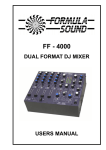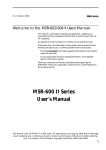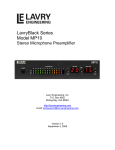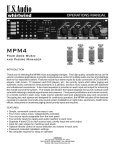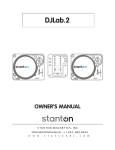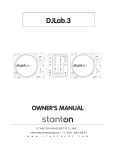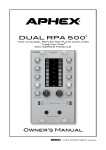Download Alpine SEC-150R Specifications
Transcript
FF - 6000 DUAL FORMAT DJ MIXER USERS MANUAL FF - 6000 INTRODUCTION The features and layout of the FF-6000 were determined in collaboration with leading loudspeaker manufacturers Funktion One, who canvassed many DJs world wide on their requirements. The result is a mixer which is not only of the highest sound quality, as you would expect from Formula Sound, but also incorporates the features and layout which DJs have asked for. Although the FF-6000 is a fixed format design the use of individual circuit cards per channel, PTH circuit boards, and all rotary controls securely mounted to the front panel, improve reliability and aid servicing should the need arise. A rear printed polycarbonate overlay to the top panel ensures that this mixer will still look good after many years of use and notation will never rub off. The FF-6000 is essentially a seven channel mixer. Six of these channels are laid out to the left of the master section and the seventh is a dedicated microphone channel labelled ‘Console Mic’ positioned to the right of the master section The six channels are each switchable to two input sources. Channels 1 and 2 are switchable between low impedance microphone and a stereo line input. Phantom power is available for microphones (internal selection). Channels 3 to 6 are switchable between a stereo line input and a phono (RIAA) or line input. (Phono/line selection is via a concealed push switch accessible through a hole in the rear panel). These 6 input channels are fully assignable to the crossfader, and feature specially designed three band equalisation with a range of +5dB to -23dB. Gain trims are provided for all inputs accessible through the rear panel, as well as a front panel gain control. An adjacent 5 segment led meter and clip warning indicator provide signal present indication and overload warning. Illuminated push switches control input selection, channel routing and cue, etc. Different shapes and sizes of push buttons along with colour coded illumination help to easily identify control functions . Removable Fader Panel The fader panel mounted beneath the 6 input channels is removable and available with either linear or rotary faders. This provides for easy removal and replacement of all faders which are all connected by gold plated connectors. A screwdriver is the only tool required to replace a fader or change the mixer from a linear to rotary fader operation. Smooth feel Alps 60mm faders which are arranged to eliminate the ingress of dirt are used for the linear fader option and superior quality rotary faders are used for the rotary option. 1 Master Section Overview Main and Zone outputs are available in stereo, along with a separate mono output. All these outputs are balanced on XLR connectors. Booth monitors output is available in stereo or switchable to mono and again these outputs are balanced on XLR connectors. A recording output is provided on gold plated phono sockets. There are 3 insert loops provided. 1 & 2 are selected via the X-fade assign buttons and feature latching and punch selector buttons along with wet / dry mixing control and gain trims. Mono and cue switches are fitted to both sections. There is also an illuminated loop swap button that allows the connected effects processors to be swapped over to the other channel. The third effects loop is connected to the main output chain. This is selected by an illuminated push button. All effects loop connectors are pairs of 3 pole jacks, each socket providing send and return paths. Visual metering is by 2 twin 12 segment led VU meters; one for cue signals and one for output signals. Comprehensive headphones monitoring is provided featuring a powerful stereo headphones amplifier. 6.5mm and 3.5mm stereo jacks are provided. A split cue switch and monitor balance control are fitted. The Console Microphone channel is located above the phones section and features two band equalisation, volume control, illuminated on-off switch and cue button. Dimensions (Exc. Knobs & connectors): Width 483mm (19”) Height 312mm (12.25"-7RU) Depth 110mm (4.33") Power Supply The Mixer has a fully regulated internal power supply that is designed to operate on 220-240Vac or 110-120Vac. Selection is by an internal switch that is accessed by removing the fader panel. DAMAGE MAY RESULT IF THE UNIT IS CONNECTED TO THE WRONG SUPPLY VOLTAGE. Fuses Mains fuse sizes are 800mA anti-surge for 220-240Vac and 1.5A anti-surge for 110-120Vac operation. It is important for safety reasons that the correct fuse sizes are always used. 2 MIC LINE 2 GAIN CLIP HF INPUT CHANNELS 1 AND 2 Input Sources. These channels have balanced low impedance low noise microphone inputs on XLR connectors and a normal stereo line input on twin gold plated RCA phono connectors. Input selector switch selects the input used. Button depressed selects Mic (XLR connector) Button not depressed selects Stereo line input. Blue and red l.e.d.s. and labels clearly show which input is in use. Channel meter. This is a 5 segment l.e.d. meter and it displays the signal level within the channel. The normal reading for this meter is amber with occasional peaks into to the red. MID BASS Gain control. This sets the input gain level, and should be used in conjunction with the rear panel gain trims. A gain trimmer is provided for every input so that all input sources can be matched to the same level. The control is then used to compensate for differences in track levels. Clip indicator. This is a red l.e.d that indicates when the channel signal is just below clipping. If lit it means that the gain is set too high. 3 Band equalisation provides +5dB boost and -23dB cut @ HF 10kHz MID 1kHz BASS 100Hz. The centre detent denotes the flat position. A X-FADE B CUE X-Fade A and B. Rectangular push button switches with red and green illumination. Depressing the switches routes the channel via the VCA controlled crossfader and associated effects loops if selected. The channel signal may be routed to either end of the X-fader. The red and green colour coding is maintained throughout the X-fader and associated effects loops to give clear visual indication of routing status. If neither button is depressed the signal is routed directly to the output section. Cue. A larger round illuminated push button is provided for cue selection. When depressed the channel signal is fed to the cue buss. Any number of sources may be selected simultaneously, the sum of which will be available to the headphones monitoring section. Fader. A 60mm channel fader (or rotary fader depending on what fader option has been fitted ) is available to mix the various channels as required. 3 PH/LINE LINE INPUT CHANNELS 3 to 6 3 GAIN CLIP HF Input Sources. These channels have a stereo RIAA phono stage and a normal stereo line input both on twin gold plated RCA phono connectors. The phono stage may be configured as a second line input by depressing a concealed push switch available through a hole in the rear panel. Input selector switch selects the input used. Button depressed selects Phono/line (depending on configuration). Button not depressed selects Stereo line input. Blue and red l.e.d.s. and labels clearly show which input is in use. Channel meter this is a 5 segment l.e.d. meter and it displays the prefader signal level within the channel. The normal reading for this meter is amber with occasional peaks into the red. MID BASS Gain control. This sets the input gain level, and should be used in conjunction with the rear panel gain trims. A gain trimmer is provided for every input so that all input sources can be matched to the same level. The control is then used to compensate for differences in track levels. Clip indicator. This is a red l.e.d that indicates when the channel signal is just below clipping. If lit it means that the gain is set too high. 3 Band equalisation provides +5dB boost and -23dB cut @ HF 10kHz MID 1kHz BASS 100Hz. The centre detent denotes the flat position. A X-FADE B X-Fade A and B. Rectangular push button switches with red and green illumination. Depressing the switches routes the channel via the VCA controlled crossfader and associated effects loops if selected. The channel signal may be routed to either end of the X-fader. CUE The red and green colour coding are maintained through out the X-fader and associated effects loops to give clear visual indication of routing status. If neither button is depressed the signal is routed directly to the output section. Cue. A larger round illuminated push button is provided for cue selection. When depressed the channel signal is fed to the cue buss. Any number of sources may be selected simultaneously, the sum of which will be available to the headphones monitoring section. Fader. A 60mm channel fader (or rotary fader depending on what fader option has been fitted ) is available to mix the various channels as required. 4 Master section ZONE LEVEL O/P Meter FX 1 Trim MONO CUE O/P +8 +8 +5 +5 +3 +3 +1 +1 0 0 -1 -1 -3 -3 -5 -5 -7 -7 -10 -10 -15 -15 -20 -20 dB dB MONO MASTER HF LEVEL MIC ON FX 2 VOL Trim CUE MONO Bal / Pan R L BOOTH MONITORS CUE LF INSERT IN / OUT Bal / Pan L CONSOLE MIC R CUE BAL CUE CUE Fx Loop 1 LOOP SWAP Fx Loop 2 MIX Fx Loop 1 SPLIT Fx Loop 2 X-FADE Latch ON Latch ON Fx Mix Fx Mix PHONES Contour OFF Wet Dry Assignment Wet Dry 32 Ohm To Both A & B Punch Punch Direct to Masters A B The master section contains all the electronics required for the various summing amplifiers, output stages, VU meters, crossfade control circuits, etc. Monitoring The monitoring section of the FF-6000 is very comprehensive. Visual monitoring is provided by 2 stereo 24 segment l.e.d. bargraph meters, 1 for cue signals and one for output signals. A powerful stereo headphone amplifier is incorporated designed to drive headphones of 32 ohms or greater. Connections are via a 6.5mm or a 3.5mm 3 pole jack socket. Simultaneous use of both sockets is not possible. The cue meter and the phones output are both connected to the same signal so what you see is what you hear. CUE BAL (Cue Balance) It is important that the function of this control is fully understood. The output from this control is fed to the monitoring section (the cue bargraph meter) and via the PHONES volume control to the main phones output. With the control turned fully counter clockwise towards cue, the meter will read the cue signal of any channel or effects loop that has its cue button depressed, or the sum of channels if more than one is selected. If no cue buttons are depressed the meter reads the main output level which is dependent on the MASTER control setting. Turning the monitor balance control clockwise towards MIX feeds the programme signal (pre master) to the monitoring section. Therefore the operator can quickly pan or mix between the PFL and mixer output. It also facilitates the monitoring of a recording being made with the master turned down. A SPLIT button is also provided (which is the preference of some operators). This provides a mono CUE signal on one side of the monitor system and a mono program signal on the other side. The Mon Bal sets the balance of the two signals in this situation. Practice and use will determine the best mode of operation. Do not use headphones with an impedance lower than 32 ohms. MASTER - This control sets the output level of the main balanced stereo and mono outputs, available via 3 pin XLR connectors on the back panel. This output is monitored by the main phones and VU meter when the CUE BAL control is set to CUE and no CUE is selected. The VU meter is factory calibrated 0dB = 0dBu (775mV) ZONE -The zone output is almost identical to the main output in all respects except that the signal is not available to the headphones monitoring section. The zone output level may be checked by depressing the O/P Meter button located beneath the ZONE LEVEL control. This switch allows the o/p meter to read either main output or zone output. RECORD OUTPUTS - A pair of gold plated phono sockets are provided for the connection of stereo recording equipment. The record outputs are not affected by the master level controls. 5 Master section continued BOOTH MONITORS - This control adjusts the level of the booth monitors output which is a mix of channels 1 to 6 only (console microphone not present in either output). The balanced outputs are via 3 pin XLR connectors. A mono signal may be obtained by using mono button located above. INSERTS - General information Insert sockets in the form of 3 pole 1/4” jacks are provided in pairs for the connection of external signal processing or effects equipment. Located on the back panel the connections are:Tip = send (mixer output) Ring = return (mixer input) Body = common (ground) Sockets are provided for effects loops 1 and 2 and the main output channels INSERT IN / OUT - This switch allows the selection of external equipment inserted into the main insert sockets. This affects the main and zone outputs. FX LOOPS 1 and 2 - Very comprehensive facilities are provided for adding external effects into the mix. The two loops provided have identical controls. Routing to the effects loops follows the X-fade assign buttons on channels 1 to 6. The effects send signals may be reduced via a rear panel trimmer located above the loop connectors. This is to ensure that overloading of sensitive input stages is avoided and the correct level is available to effects processors. An effects return gain trimmer ( FX1 Trim and FX2 Trim) allows the correct level to be reintroduced into the mix. Dry / Wet - Once enabled this control mixes between the direct signal (effects unit input) and the effects unit output. It is provided to mix the required amount of effect. With the control set to fully Dry no effect is added. With the control set to fully Wet just the effect return is added to the mix and the original signal is removed. Momentary punch and latching switches enables the Wet / Dry controls. CUE - This button allows the operator to set up the required effect on the headphones before the effect is selected. LOOP SWAP - This switch allows the effects processors to be swapped e.g. if just one processor was in use and connected to FX1 ( routed from X-FA) it could be used in loop 2 (routed from X-FB) just by depressing LOOP SWAP. The red and green l.e.d.s also change over as a reminder that Swap is selected. CROSSFADE - The crossfader is a 45mm fader which can be used to smoothly fade between the XF-A and XF-B busses and any added effects. The crossfade system uses studio quality V.C.A.’s (voltage controlled amplifiers) to improve crossfader life and also ensure good attenuation at the ends of travel. CONTOUR - A contour control is provided which allows the operator to adjust the crossfader characteristics to suit personal taste, from a gentle fade between A and B to a more aggressive fade towards the ends of the fader. CROSSFADE OFF - An illuminated push switch operated through a hole in the front panel is fitted below the contour control. When depressed the crossfader is disabled. Both FX1 and FX2 loops will still be operational. CONSOLE MIC - A dedicated microphone channel is available. The controls are positioned to the top right corner above the headphones section. Two band equalisation is fitted providing +/- 12dB @ 10kHz (HF) and +/- 12dB @100Hz (LF) An illuminated ON /OFF push switch, volume control, and illuminated CUE push switch complete the controls. This Microphone channel is not present in the booth monitors. 6 Operational Information or how to get the best out of your mixer Gain In an audio mixer different signal levels from various items of equipment need to be amplified or attenuated to a common level so that they can be added or mixed together. These signal levels may differ considerably depending on the equipment. The signal from a microphone, for example, may be 1000 times smaller than that from a CD player. For a mixer to be as flexible as possible and to accept signals from a variety of equipment it is necessary for the first or early stage in the input circuit to be a variable gain amplifier. The gain of this amplifier is set by the gain control. The FF-6000 has a combination of variable gain amplifiers to get the input signals to the required operating level. Gain trim presets are fitted - 1 for each input. These are accessible through holes on the back panel and are labelled accordingly. The stereo input gain trims are conventional single turn controls. The Mic preset is a multi-turn trimmer. These trims should be adjusted to set the maximum gain available for any input. The front panel gain control works in conjunction with these presets. The system may be considered as coarse gain control on the rear presets and fine adjustment on the front gain control. When amplifier gain is introduced in a circuit noise is also introduced. (This is a fact - you cannot have one without the other). The FF-6000 has been designed to keep this noise as low as possible by using the latest technology. For the best performance set the gain control as low as possible to achieve the desired output level. Gain introduced into the system and then held on the channel fader is a waste of performance. Too much gain could result in overloading the first stage causing distortion and clipping. A clip indicator has been included and is located below the front panel gain control. This indicator flashes when the signal level is close to clipping. It monitors the signal at various points in the signal chain, therefore, gain introduced by the equalisation or tone controls is also considered. IF THE PEAK INDICATOR ILLUMINATES DURING USE TURN DOWN THE GAIN CONTROL (OR INPUT TRIM PRESETS). INSTALLATION, CONNECTIONS AND GOOD WIRING PRACTICE The installation of professional audio systems should be left to experienced engineers wherever possible. The interconnection of audio systems can be fairly complex depending on the type and size of system and obviously well outside the scope of this handbook. We have included a few basic points for information for anyone who is new to audio systems. Good wiring practice should be observed when connecting any audio equipment. Good quality connectors and screened cable should be used for all audio connections . Twin screened cable should be used for all balanced lines particularly microphone connections. Always ensure cable clamps in connectors are fully tightened and gripping the outer sheath. Good strain relief and mechanically sound connections will increase reliability at virtually no extra cost. GROUND LOOPS In our experience this is the most common problem encountered when connecting together different items of audio equipment. It is the most common cause of hum (50Hz noise) on a system and is caused by incorrect system grounding. When several items of audio equipment are connected together with unbalanced connections (i.e. 2 connections, single screened cable, etc.) the signal common connection is the screen and this will be connected to mains earth at some point. If several items of equipment have their signal common connected to mains earth this will form a loop (hence ground loop). Current will flow in this loop and appear in the form of hum (50Hz mains frequency) added to the audio signal. The problem is aggravated if the equipment is located a distance apart as the loop is larger. It is possible to have several ground loops within a system. The solution is to connect the system to mains ground only once. This is usually done at the mixer. You will need to investigate the various items of equipment you are using and isolate their signal common from mains earth. Many manufacturers fit a ground lift switch for this purpose. On some equipment this is in the form of a removable link. Unfortunately with some equipment you have to get inside to identify where the connection is and remove it. You must not disconnect the mains earth wire from the mains plug of any equipment. This is fitted for safety reasons and must be connected to ensure that the case is earthed. 7 Formula Sound reserve the right to alter specifications at any time without notice. All Formula Sound products are designed and manufactured in our own factory which enables us to maintain strict quality at every stage of manufacture. This attention to detail has helped to win us 14 industry awards to date and has earned us a world wide reputation for the high quality and reliability of our products. Formula Sound Ltd. Ashton Road, Bredbury, Stockport, Cheshire, England. SK6 2SR Tel +44 (0)161 494 5650 Fax +44(0)161 494 5651 E-mail [email protected] Internet http://www.formula-sound.com 8 FF- 6000 Specifications Frequency response E.Q. set flat 20Hz - 20kHz +/-0.5dB Maximum output level Main output Zone output and Booth monitors output active balanced. +22dBu Distortion any input < 0.01% typically <0.005% Noise measured 20Hz-20kHz Stereo inputs e.q. flat gain set to max RIAA stage ref. 5mV 1kHz Input shorted Microphone input (ref 150R) EIN < -98dB -80dBV “A” weighted EIN < -124dBU Gain Stereo inputs rear trim @ max Stereo inputs rear trim @ min Microphone input max Microphone input min +/- 15dB + 0dB -20dB + 75db + 0dB Maximum input level Stereo input A (line) Stereo input A (RIAA) Stereo input B Microphone +20dBV -8dBV 400mV +20dBV +4 dBV Input Impedances Stereo input A Stereo input B Microphone input > 47k ohms > 10k ohms > 2k ohms active balanced Equalisation 3 band e.q. per channel +5dB -23 dB @ Treble 10kHz Mid 1kHz, Bass 100Hz Dimensions (Exc. Knobs & connectors): Width 483mm (19”) Height 312mm (12.25"-7RU) Depth 110mm (4.33") Balanced outputs For unbalanced operation strap pins 1&3 to ground and use pin 2 hot. This will result in no loss of output level or performance.










